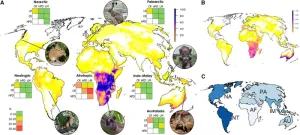(Press-News.org) PITTSBURGH, April 10, 2023 – Black and Hispanic older adults whose annual income is slightly above the federal poverty level are more likely than their white peers to face cost-related barriers to accessing health care and filling medications for chronic conditions, according to new research led by a University of Pittsburgh School of Public Health scientist.
Published today in JAMA Internal Medicine, the analysis links these disparities to a Medicaid “cliff” – an abrupt end to supplemental Medicaid insurance when people clear the federal poverty threshold. For older adults, Medicaid helps to lower out-of-pocket health care costs by covering most Medicare co-pays. However, a cutoff in Medicaid eligibility above the poverty threshold leads to a sudden rise in copays, making it harder for Black and Hispanic older adults with modest incomes to afford care, compared to their white counterparts at similar income levels.
“Chronic disease risks among older adults of color often go unaddressed due to cost-related barriers to care, and our research shows that this Medicaid cliff contributes to these barriers,” said Eric T. Roberts, Ph.D., assistant professor of health policy and management at Pitt Public Health. “Fixing this so that people on Medicare don’t face substantially higher co-pays above the poverty threshold could lessen health care inequities among our nation’s seniors.”
“One option is to turn the ‘cliff’ into a ‘gentle hill,’ by tapering Medicaid assistance for seniors with incomes slightly above the federal poverty threshold,” Roberts added.
Medicare, the federal health care insurance program for people age 65 and older and disabled individuals, can come with high cost-sharing, including deductibles and copays. Medicare beneficiaries with income less than 100% of the federal poverty threshold, about $14,600 annually, receive supplemental Medicaid insurance to offset these costs and automatically receive a subsidy to lower out-of-pocket prescription drug costs. However, unlike other federal programs that taper aid on a sliding scale, such as the Supplemental Nutrition Assistance Program that helps people buy food, those with incomes even slightly above the poverty line are cut off from Medicaid.
Roberts and his colleagues obtained data on 8,144 Medicare beneficiaries with incomes less than 200% of the federal poverty level. They looked at health care use for beneficiaries on either side of the Medicaid eligibility line, comparing outcomes among Black and Hispanic beneficiaries to white beneficiaries.
Being just above the federal poverty threshold, and therefore ineligible for Medicaid, was associated with a 21% drop in annual outpatient visits and a 15% drop in prescriptions filled for Black and Hispanic Medicare beneficiaries, but barely any change for white beneficiaries.
“We found — and other research supports — that white beneficiaries are more likely to have savings to draw upon to cover medical costs,” Roberts said. “The income that the federal government looks at to determine Medicaid eligibility may make it appear that Black and Hispanic beneficiaries have the same ability as their white peers to pay for care. But the reality is that they don’t have the same reserves — and we’re seeing the impact of that in their forgoing doctor’s visits and needed medications.”
Black and Hispanic Medicare beneficiaries are more likely to have chronic diseases that can be managed with medications, such as diabetes and heart disease, than white beneficiaries.
“The Medicaid ‘cliff’ is doubly concerning because it results in Black and Hispanic adults filling fewer medications and makes it harder for them to keep up with regular doctor’s appointments, making it harder to get prescription medications in the first place,” Roberts said.
The findings support broadening Medicaid eligibility for older adults and tapering Medicaid assistance above the poverty threshold. Such changes could complement measures in the Inflation Reduction Act designed to make drug costs more affordable for seniors, the researchers noted.
Additional authors of this study are Youngmin Kwon, B.A., and Alexandra G. Hames, B.A., both of Pitt; J. Michael McWilliams, M.D., Ph.D., of Harvard University and Brigham and Women’s Hospital; and John Z. Ayanian, M.D., M.P.P., and Renuka Tipirneni, M.D., M.Sc., both of the University of Michigan.
END
Medicaid ‘cliff’ adds to racial and ethnic disparities in care for near-poor seniors
2023-04-10
ELSE PRESS RELEASES FROM THIS DATE:
Potential drug treats fatty liver disease in animal models, brings hope for first human treatment
2023-04-10
A recently developed amino acid compound successfully treats nonalcoholic fatty liver disease in non-human primates — bringing scientists one step closer to the first human treatment for the condition that is rapidly increasing around the world, a study suggests.
Researchers at Michigan Medicine developed DT-109, a glycine-based tripeptide, to treat the severe form of fatty liver disease called nonalcoholic steatohepatitis. More commonly known as NASH, the disease causes scarring and inflammation in the liver and is estimated to affect up to 6.5% of the global population.
Results ...
Scientists show how we can anticipate rather than react to extinction in mammals
2023-04-10
Most conservation efforts are reactive. Typically, a species must reach threatened status before action is taken to prevent extinction, such as establishing protected areas. A new study published in the journal Current Biology on April 10 shows that we can use existing conservation data to predict which currently unthreatened species could become threatened and take proactive action to prevent their decline before it is too late.
“Conservation funding is really limited,” says lead author Marcel Cardillo (@MarcelCardillo) of Australian National University. “Ideally, what we need is some way of anticipating species that may not be threatened ...
This elephant’s self-taught banana peeling offers glimpse of elephants’ broader abilities
2023-04-10
Elephants like to eat bananas, but they don’t usually peel them first in the way humans do. A new report in the journal Current Biology on April 10, however, shows that one very special Asian elephant named Pang Pha picked up banana peeling all on her own while living at the Berlin Zoo. She reserves it for yellow-brown bananas, first breaking the banana before shaking out and collecting the pulp, leaving the thick peel behind.
The female elephant most likely learned the unusual peeling behavior ...
Health care access, affordability among adults with self-reported post–COVID-19 condition
2023-04-10
About The Study: In this survey study of 9,400 adults ages 18 to 64, a higher rate of respondents with self-reported post–COVID-19 condition (PCC; also known as long COVID) did not obtain needed health care in the past year because of cost compared with adults without PCC. Adults with PCC were also more likely to have unmet needs because of difficulties getting timely appointments or health plan authorization, among other challenges with health care institutions or health insurance. These findings suggest that improved health care access for adults with PCC may require developing clinical protocols and addressing insurance-related barriers.
Authors: Michael ...
Changes in children’s screen time during pandemic
2023-04-10
About The Study: The largest increase in children’s recreational screen time during the pandemic was on weekdays, especially at the outset of the pandemic when schools were closed; this increase was greater than expected for age-related growth. Change in weekend screen time during the pandemic was not significant compared with weekday screen time. Once in-person school resumed, weekday screen time decreased versus that during the COVID-1 wave (spring 2020), although it remained consistently higher than pre-pandemic estimates and age-related expectations.
Authors: Sheri Madigan, Ph.D., of the University of Calgary in Calgary, Canada, is the corresponding ...
Study: Shutting down nuclear power could increase air pollution
2023-04-10
Nearly 20 percent of today’s electricity in the United States comes from nuclear power. The U.S. has the largest nuclear fleet in the world, with 92 reactors scattered around the country. Many of these power plants have run for more than half a century and are approaching the end of their expected lifetimes.
Policymakers are debating whether to retire the aging reactors or reinforce their structures to continue producing nuclear energy, which many consider a low-carbon alternative to climate-warming coal, oil, and natural gas.
Now, MIT researchers say there’s another factor to consider in weighing the future of nuclear power: ...
Study shows involuntary displacement of people experiencing homelessness may cause significant spikes in mortality, overdoses and hospitalizations
2023-04-10
AURORA, Colo. (April 10, 2023) – Involuntary displacement of people experiencing homelessness will likely lead to a substantial increase in morbidity and mortality over a 10-year period.
In a study, published today in the Journal of the American Medical Association (JAMA), researchers say practices such as encampment sweeps, bans, move-along-orders and cleanups that forcibly relocate individuals away from essential services will lead to substantial increases in overdose deaths, life threatening infections and hospitalizations.
In coordination with the National Healthcare for Homeless Council, the Center for Disease Control and Prevention (CDC) and the National Foundation ...
Protein Beclin-1 is a major player in uterine remodeling and the establishment of pregnancy
2023-04-10
Throughout a woman's reproductive life, the endometrium, the mucous membrane lining the uterus, goes through cyclical remodeling. It thickens during the menstrual cycle in preparation for embryo implantation, and it is shed during menstruation when there is no fertilization.
Researchers at Baylor College of Medicine and collaborating institutions are investigating little-known factors directing uterine remodeling to advance the understanding of this process and provide new insights into fertility-associated gynecological conditions. They report today in the journal Developmental ...
Scientists map gusty winds in a far-off neutron star system
2023-04-10
An accretion disk is a colossal whirlpool of gas and dust that gathers around a black hole or a neutron star like cotton candy as it pulls in material from a nearby star. As the disk spins, it whips up powerful winds that push and pull on the sprawling, rotating plasma. These massive outflows can affect the surroundings of black holes by heating and blowing away the gas and dust around them.
At immense scales, “disk winds” can offer clues to how supermassive black holes shape entire galaxies. Astronomers have observed signs of disk winds in many systems, ...
Health effects of involuntary displacement of homeless individuals who inject drugs
2023-04-10
About The Study: This simulation modeling study of 23 U.S. cities projects that involuntary displacement of people experiencing homelessness who inject drugs may yield substantial increases in morbidity and mortality over a 10-year period. Involuntary displacement is estimated to worsen overdose and hospitalizations, decrease initiations of medications for opioid use disorder, and contribute to deaths. These findings have implications for the practice of involuntary displacement, as well as policies such as access to housing and supportive services, that could mitigate these harms.
Authors: Joshua A. Barocas, M.D., ...




